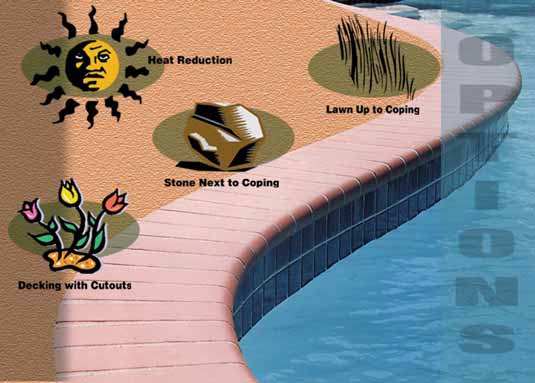Natural Companions
A good friend of mine once told me that his idea of the perfect yard was one where he could walk around naked - and none of his neighbors would be able to see him. What a concept! Unfortunately, few of us can afford a yard so large that we could not be seen by neighbors under any circumstances. So what can you do to create that perfect private environment? As we'll see here, you have a lot of choices. DISCOVERING PREFERENCES Many people go all the way in creating privacy by building structures that make them feel safe and enclosed. Others prefer a less claustrophobic approach, such as soft plantings. Either way, and particularly when you are dealing with watershapes where your clients may want to enjoy communing with nature in the buff, creating some type of barrier against neighbors' intruding eyes is essential. Your clients' preferences may
Your clients are thrilled with your pool design - with one exception. It may be set up to withstand a 9.0 earthquake, but with all that decking and concrete, it resembles a bomb shelter. Apparently while you were working with the client's desire for seismic durability in mind, you lost sight of their additional desire for soft, rolling meadows. I exaggerate here to make a point: Too many watershapers are reluctant to
By repeating something from one place in the yard to another, you tie everything together - and expand upon an idea that has already worked somewhere else in that yard. With landscaping, this doesn't always have to mean plants. When you find something that works and you like it, why not stick with it? Last month, I told you how we turned a small wasteland into an indoor oasis for one of my clients. When we were finished with the project, the clients were
What do you do with a space that seems too small for a watershape and too small for plantings? The answer: Think small. You don't have to compromise on style or substance, but simply by thinking on a smaller scale, you'll open up a lot of possibilities you might not have considered. About three years ago, for example, I was brought in on a job to do a quick fix for a very small but prominent area of a client's yard. The homeowner wanted to completely rework the entire property, but it was clear there was a lot of other work to do first. The quick fix went very well and the clients were pleased, so they asked me to
When we think of water, much of the time we think of a tropical scene - Hawaii, the Caribbean or some other exotic island somewhere - a place we'd all like to go. Why not create that "somewhere else" in your clients' backyards? They'll thank you for all the money you'll save them on that cruise that probably would have been less than perfect anyway. And this tropical scene will be one they can enjoy not only this week, but for as long as they want. Imagine palm trees swaying in the wind, the sweet smell of
Let's say your clients have spent all their loose change on your watershape and can't afford to hire a landscape designer or architect. They don't even want to meet that wonderful person you've been telling them about. So why not suggest a few plants that will really spiff up their new backyard Niagara Falls? If you're brave enough to try, I'll help you here and in a couple of future columns. Let's start by talking about
I've had the pleasure over the past few years of working with a client who ultimately has become a good friend - and with whom I created a very unique garden. The process of designing the space was lengthy, but it afforded me time to truly understand my client and her wants. As we progressed, many issues arose that needed to be addressed; over time and at many points, patience was indeed a virtue. Her yard had existing structures as well as large Eucalyptus, Pittosporum and Chorisia trees and other plantings along with
Among the most complicated tasks you'll encounter in designing a watershape is determining your clients' style and how it applies to the project. How important is it to know what style they want? That's a complicated
Surely you've heard this line before and never believed it, but I'm here to tell you that size does matter. Have you ever, for example, built a pond or fountain with concrete either surrounding it or fanning out from it beneath the soil - and then had your clients say they wanted a very mature tree or shrub planted right up against the edge? There you are with six inches of soil (maximum!) to work with, and there's just no way to
Before we dive into discussions of plantings or the various components of landscaping work, I think it's important to define roles and talk about relationships among the trades involved in watershaping projects - in other words, to take a basic look at who does what. We can all save time and money by knowing from the beginning of the job who is going to handle each phase and detail as well as who is qualified, trained or licensed to perform the various tasks needed to get the job done. Planning this up front might even result in greater profits, and it definitely will make your job easier. I know it's the goal of this magazine to build a greater "watershaping community" where both landscape professionals and those who






















